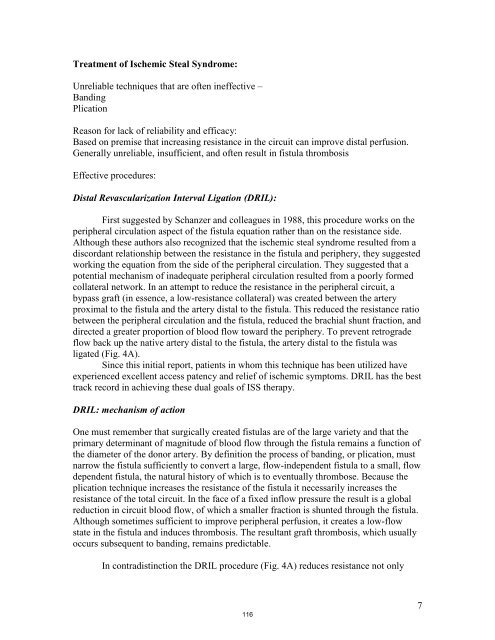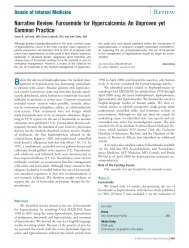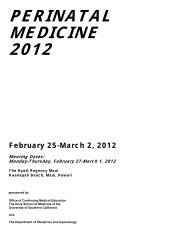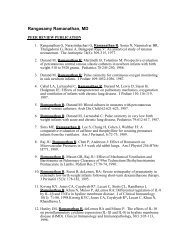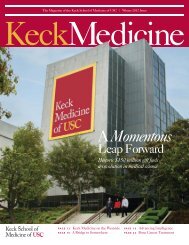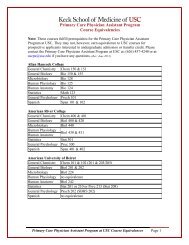Program Book - Keck School of Medicine of USC - University of ...
Program Book - Keck School of Medicine of USC - University of ...
Program Book - Keck School of Medicine of USC - University of ...
- No tags were found...
You also want an ePaper? Increase the reach of your titles
YUMPU automatically turns print PDFs into web optimized ePapers that Google loves.
Treatment <strong>of</strong> Ischemic Steal Syndrome:Unreliable techniques that are <strong>of</strong>ten ineffective –BandingPlicationReason for lack <strong>of</strong> reliability and efficacy:Based on premise that increasing resistance in the circuit can improve distal perfusion.Generally unreliable, insufficient, and <strong>of</strong>ten result in fistula thrombosisEffective procedures:Distal Revascularization Interval Ligation (DRIL):First suggested by Schanzer and colleagues in 1988, this procedure works on theperipheral circulation aspect <strong>of</strong> the fistula equation rather than on the resistance side.Although these authors also recognized that the ischemic steal syndrome resulted from adiscordant relationship between the resistance in the fistula and periphery, they suggestedworking the equation from the side <strong>of</strong> the peripheral circulation. They suggested that apotential mechanism <strong>of</strong> inadequate peripheral circulation resulted from a poorly formedcollateral network. In an attempt to reduce the resistance in the peripheral circuit, abypass graft (in essence, a low-resistance collateral) was created between the arteryproximal to the fistula and the artery distal to the fistula. This reduced the resistance ratiobetween the peripheral circulation and the fistula, reduced the brachial shunt fraction, anddirected a greater proportion <strong>of</strong> blood flow toward the periphery. To prevent retrogradeflow back up the native artery distal to the fistula, the artery distal to the fistula wasligated (Fig. 4A).Since this initial report, patients in whom this technique has been utilized haveexperienced excellent access patency and relief <strong>of</strong> ischemic symptoms. DRIL has the besttrack record in achieving these dual goals <strong>of</strong> ISS therapy.DRIL: mechanism <strong>of</strong> actionOne must remember that surgically created fistulas are <strong>of</strong> the large variety and that theprimary determinant <strong>of</strong> magnitude <strong>of</strong> blood flow through the fistula remains a function <strong>of</strong>the diameter <strong>of</strong> the donor artery. By definition the process <strong>of</strong> banding, or plication, mustnarrow the fistula sufficiently to convert a large, flow-independent fistula to a small, flowdependent fistula, the natural history <strong>of</strong> which is to eventually thrombose. Because theplication technique increases the resistance <strong>of</strong> the fistula it necessarily increases theresistance <strong>of</strong> the total circuit. In the face <strong>of</strong> a fixed inflow pressure the result is a globalreduction in circuit blood flow, <strong>of</strong> which a smaller fraction is shunted through the fistula.Although sometimes sufficient to improve peripheral perfusion, it creates a low-flowstate in the fistula and induces thrombosis. The resultant graft thrombosis, which usuallyoccurs subsequent to banding, remains predictable.In contradistinction the DRIL procedure (Fig. 4A) reduces resistance not only1167


